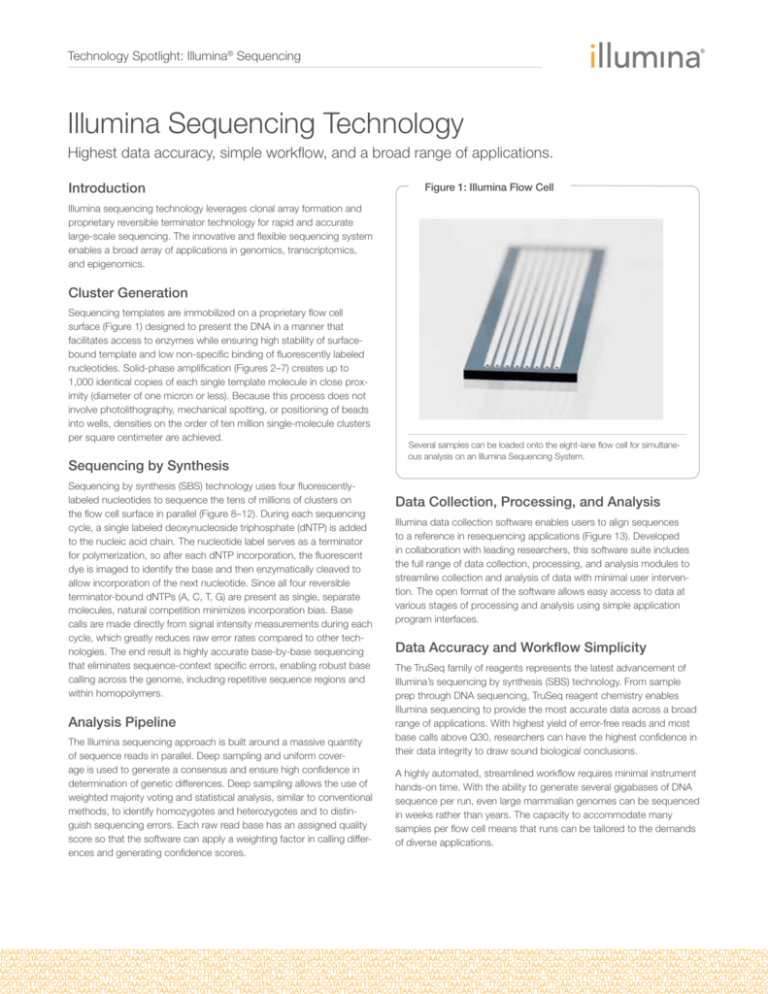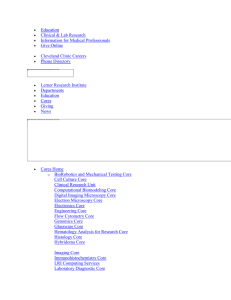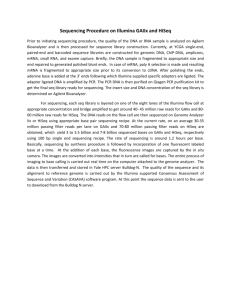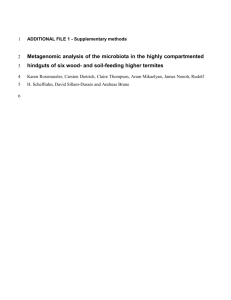
Technology Spotlight: Illumina® Sequencing
Illumina Sequencing Technology
Highest data accuracy, simple workflow, and a broad range of applications.
Introduction
Figure 1: Illumina Flow Cell
Illumina sequencing technology leverages clonal array formation and
proprietary reversible terminator technology for rapid and accurate
large-scale sequencing. The innovative and flexible sequencing system
enables a broad array of applications in genomics, transcriptomics,
and epigenomics.
Cluster Generation
Sequencing templates are immobilized on a proprietary flow cell
surface (Figure 1) designed to present the DNA in a manner that
facilitates access to enzymes while ensuring high stability of surfacebound template and low non-specific binding of fluorescently labeled
nucleotides. Solid-phase amplification (Figures 2–7) creates up to
1,000 identical copies of each single template molecule in close proximity (diameter of one micron or less). Because this process does not
involve photolithography, mechanical spotting, or positioning of beads
into wells, densities on the order of ten million single-molecule clusters
per square centimeter are achieved.
Sequencing by Synthesis
Sequencing by synthesis (SBS) technology uses four fluorescentlylabeled nucleotides to sequence the tens of millions of clusters on
the flow cell surface in parallel (Figure 8–12). During each sequencing
cycle, a single labeled deoxynucleoside triphosphate (dNTP) is added
to the nucleic acid chain. The nucleotide label serves as a terminator
for polymerization, so after each dNTP incorporation, the fluorescent
dye is imaged to identify the base and then enzymatically cleaved to
allow incorporation of the next nucleotide. Since all four reversible
terminator-bound dNTPs (A, C, T, G) are present as single, separate
molecules, natural competition minimizes incorporation bias. Base
calls are made directly from signal intensity measurements during each
cycle, which greatly reduces raw error rates compared to other technologies. The end result is highly accurate base-by-base sequencing
that eliminates sequence-context specific errors, enabling robust base
calling across the genome, including repetitive sequence regions and
within homopolymers.
Analysis Pipeline
The Illumina sequencing approach is built around a massive quantity
of sequence reads in parallel. Deep sampling and uniform coverage is used to generate a consensus and ensure high confidence in
determination of genetic differences. Deep sampling allows the use of
weighted majority voting and statistical analysis, similar to conventional
methods, to identify homozygotes and heterozygotes and to distinguish sequencing errors. Each raw read base has an assigned quality
score so that the software can apply a weighting factor in calling differences and generating confidence scores.
Several samples can be loaded onto the eight-lane flow cell for simultaneous analysis on an Illumina Sequencing System.
Data Collection, Processing, and Analysis
Illumina data collection software enables users to align sequences
to a reference in resequencing applications (Figure 13). Developed
in collaboration with leading researchers, this software suite includes
the full range of data collection, processing, and analysis modules to
streamline collection and analysis of data with minimal user intervention. The open format of the software allows easy access to data at
various stages of processing and analysis using simple application
program interfaces.
Data Accuracy and Workflow Simplicity
The TruSeq family of reagents represents the latest advancement of
Illumina’s sequencing by synthesis (SBS) technology. From sample
prep through DNA sequencing, TruSeq reagent chemistry enables
Illumina sequencing to provide the most accurate data across a broad
range of applications. With highest yield of error-free reads and most
base calls above Q30, researchers can have the highest confidence in
their data integrity to draw sound biological conclusions.
A highly automated, streamlined workflow requires minimal instrument
hands-on time. With the ability to generate several gigabases of DNA
sequence per run, even large mammalian genomes can be sequenced
in weeks rather than years. The capacity to accommodate many
samples per flow cell means that runs can be tailored to the demands
of diverse applications.
Technology Spotlight: Illumina® Sequencing
Figure 2: Prepare Genomic DNA Sample
Figure 3: Attach DNA to Surface
Adapter
DNA
fragment
DNA
Dense lawn
of primers
Adapters
Randomly fragment genomic DNA and ligate adapters to both ends of the
fragments.
Figure 4: Bridge Amplification
Adapter
Bind single-stranded fragments randomly to the inside surface of the flow
cell channels.
Figure 5: Fragments Become Double Stranded
Attached Free
terminus terminus
Add unlabeled nucleotides and enzyme to initiate solid-phase bridge
amplification.
Attached
terminus
The enzyme incorporates nucleotides to build double-stranded bridges on
the solid-phase substrate.
Technology Spotlight: Illumina® Sequencing
Figure 6: Denature the Double-Standed Molecules
Figure 7: Complete Amplification
Attached
Attached
Clusters
Denaturation leaves single-stranded templates anchored to the substrate.
Figure 8: Determine First Base
Several million dense clusters of double-stranded DNA are generated in
each channel of the flow cell.
Figure 9: Image First Base
Laser
The first sequencing cycle begins by adding four labeled reversible
terminators, primers, and DNA polymerase.
After laser excitation, the emitted fluorescence from each cluster is captured
and the first base is identified.
Technology Spotlight: Illumina® Sequencing
Figure 10: Determine Second Base
Figure 11: Image Second Chemistry Cycle
Laser
The next cycle repeats the incorporation of four labeled reversible
terminators, primers, and DNA polymerase.
Figure 12: Sequencing Over Multiple Chemistry Cycles
After laser excitation, the image is captured as before, and the identity of
the second base is recorded.
Figure 13: Align Data
Laser
GCTGA...
The sequencing cycles are repeated to determine the sequence of bases in
a fragment, one base at a time.
The data are aligned and compared to a reference, and sequencing
differences are identified.
Technology Spotlight: Illumina® Sequencing
Additional Information
Visit our website or contact us at the address below to learn more about Illumina sequencing technology and applications.
Illumina, Inc. • 9885 Towne Centre Drive, San Diego, CA 92121 USA • 1.800.809.4566 toll-free • 1.858.202.4566 tel • techsupport@illumina.com • illumina.com
For research use only
© 2010 Illumina, Inc. All rights reserved.
Illumina, illuminaDx, Solexa, Making Sense Out of Life, Oligator, Sentrix, GoldenGate, GoldenGate Indexing, DASL, BeadArray, Array
of Arrays, Infinium, BeadXpress, VeraCode, IntelliHyb, iSelect, CSPro, GenomeStudio, Genetic Energy, HiSeq and HiScan are registered
trademarks or trademarks of Illumina, Inc. All other brands and names contained herein are the property of their respective owners.
Pub. No. 770-2007-002 Current as of 11 October 2010







